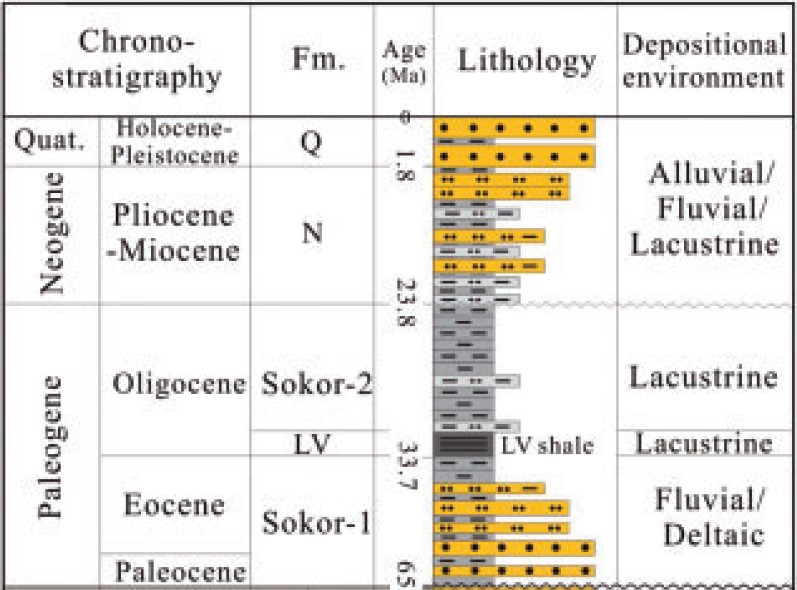Sokor 2 Fm
Type Locality and Naming
Subsurface: Wells in the Termit and Ténéré Sub-Basins
References: Nasaruddin et al., 2017; Zhou et al., 2017; Lai et al., 2020; Amadou et al., 2021.
Equivalent(s): This sub-surface formation correlates with the surface Zaouzaoua Fm, Dollé Fm, Homodji Fm
Lithology and Thickness
Mainly composed of lacustrine mudstone interbedded by thin sandstone layers. It functions as a regional seal rock for the Sokor 1 reservoirs and the Upper Cretaceous reservoir. The "LV shale marker" layer at the base of the Sokor 2 Fm (improperly known as the "LV Formation"), consisting mainly of pure lacustrine deep-water shale/mudstones, is generally accepted as the regional marker for identifying the top surface of the Sokor 1 Fm (Figure). [Note: The meaning of "LV" in "LV shale marker" is unknown.] These series of lacustrine deep-water shale/mudstones that developed in the semi-deep to deep lake environment indicate that a gradual lake expansion occurred in the Termit Sub-Basin from the Sokor 1 Fm to the LV shale marker. However, the lake level change cycle controlled the deposition process of sediments within a third-order sequence period. The LV shale marker (the seal) thins and fades out north of the Termit Sub-Basin, leaving the Ténéré Sub-Basin with no regional seal due to uplift and erosion. Thickness: 100 m in the proximal and about 500 m in the basin central (Termit Sub-Basin). The LV shale marker in the Termit Sub-Basin ranges in thickness from 50 to 150 m and is not present in the Ténéré Sub-Basin. The Sokor 2 Fm in the Ténéré Sub-Basin ranges from 30 to 1100 meters.
[Figure. Stratigraphic column of the Termit Basin showing the Sokor 1 Fm and Sokor 2 Fm and the LV shale marker at the base of Sokor 2 Fm (Source: Lai et al., 2020).]
Relationships and Distribution
Lower contact
Underlain by Sokor 1 Fm. The "LV shale marker" layer at the base of the Sokor 2 Fm, consisting mainly of pure lacustrine deep-water shale/mudstones, is generally accepted as the regional marker for identifying the top surface of the Sokor 1 Fm.
Upper contact
Overlain by the Chad Fm
Regional extent
GeoJSON
Fossils
None mentioned
Age
Depositional setting
Continental (Lacustrine). These series of lacustrine deep-water shale/mudstones that developed in the semi-deep to deep lake environment indicate that a gradual lake expansion occurred in the Termit Sub-Basin from the Sokor 1 Fm to the LV shale marker. However, the lake level change cycle controlled the deposition process of sediments within a third-order sequence period.
Additional Information
